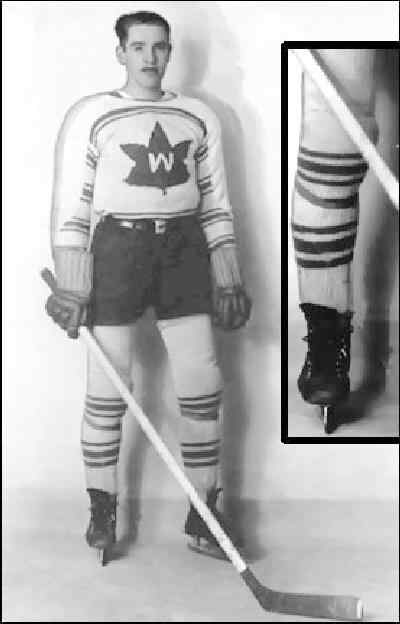
Ice Hockey

Figure 1.-- This photograph of a Canadian highschool boy probably about 18 years old was taken in 1912. This was the year when boys playing ice hockey in Canada started wearing short pants with long stockings for the game instead of long pants. A contributor writes, "I don't know what the W on the Maple Leaf background stands for on this highschool hockey player's jersey. Maybe someone in Canada will
recognise the logo, although the photograph is quite old and the highschool
may be defunct by now."
|
|
Ice hockey is played in a relatively small mumber of northern hemishere countries, but in several of the countries where it is played it has become a phenomenal passion. We do not have a lot of information on hockey yet. We notice American city boys with hockey sticks playing on rollar skates in the 1900s, presumably this was a form of ice hockey that city kids could play when an ice covered pond was not readily available. Modern uniforms are heavily padded. We are less sure about early uniforms. Ice hockey appears to have the same origins as field hockey, only played on frozen ponds in the winter. Like many modern sports, hockey appears to have evolved in the English public school, from which it was apparently brought to Canada and other countries. Ice hockey appears to have been a Canadian innovation. Some sports historians believe that it was first played at King's-Edgehill School in Windsor, Nova Scotia. Others contend that hockey was born at Halifax-Dartmouth. [Jones] We are less sure how it spread to Scandinavia and Russia. A Canadian reader tells us that the uniform evolved from the short pants and long stockings that boys once wore, even during the winter. We are not sure as to when the current uniform became an accepted convention.
Ice hockey is played in a relatively small mumber of northern hemishere countries, but in several of the countries where it is played it has become a phenomenal passion. Some of the countries where ice hockey is particularly popular include: America (northeast region), Canada, Germany, Sweden, and Russia. We do not have a lot of information on hockey yet. We notice American city boys with hockey sticks playing on rollar skates in the 1900s, presumably this was a form of ice hockey that city kids could play when an ice covered pond was not readily available. We know youth teams were popular in Canada and America. We note youth teams in Grmany, but we do not believe they were organized until after Wirkd War II.
The Game
Origins
Ice hockey appears to have the same origins as field hockey, only played on frozen ponds in the winter. Like many modern sports, hockey appears to have evolved in the English public school, from which it was apparently brought to Canada and other countries. Ice hockey appears to have been a Canadian innovation. Some sports historians believe that it was first played at King's-Edgehill School in Windsor, Nova Scotia. Others contend that hockey was born at Halifax-Dartmouth. [Jones] We are less sure how it spread to Scandinavia and Russia.
Modern uniforms are heavily padded. We are less sure about early uniforms.
A Canadian reader tells us that the uniform evolved from the short pants and long stockings that boys once wore, even during the winter. We are not sure as to when the current uniform became an accepted convention. One source suggests that Canadian high schools in 1912 introduced short pants with long stockings for the game instead of long pants. The idea was to give the players greater freedom of movement and to facilitate greater speed in skating. The stockings were held up by an elastic garter belt with four garters attached (still standard equipment today). The boys wore shin guards under the stockings below the knee which they secured originally by rubber strips made from inner tubes (see closeup of the lower leg in the insert). Today velcro straps are used instead. Note that in this photo the boy wears his hockey jersey with a belt and the jersey is tucked into his shorts. Later it was discovered that boys would have more freedom of movement if they wore suspenders to hold up the shorts and then wore the jersey on top without being tucked in, which is what boys now wear during games. We notice schools playing with these short pants uniforms into the 1930s. An example here is the Holderness School in 1930-31.
Sources
HBC

Navigate the Boys' Historical Clothing Web Site:
[Return to Main individual sports page]
[Introduction]
[Activities page]
[Biographies]
[Chronology]
[Clothing styles]
[Countries]
[Sports]
[Bibliographies]
[Contributions]
[Essay]
[FAQs]
[Glossaries]
[Images]
[Links]
[Registration]
[Tools]
[Boys' Clothing Home]
Navigate the Boys' Historical Clothing Web Site:
[Fauntleroy suits]
[Sailor suits]
[Sailor hats]
[Buster Brown suits]
[Eton suits]
[Rompers]
[Tunics]
[Smocks]
[Pinafores]
Created: May 8, 2004
Last updated: 12:01 PM 1/28/2011



